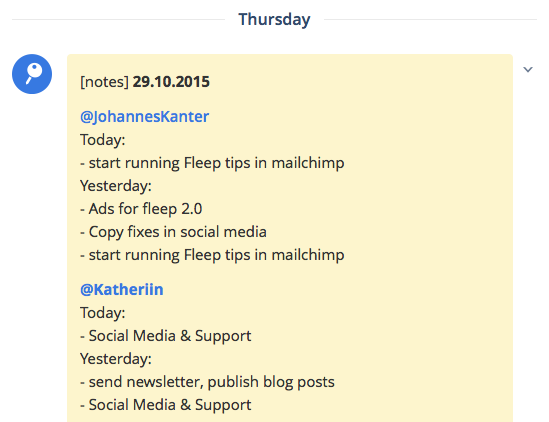What does it mean to be working? Matt Mullenweg, the founding developer of WordPress, discusses in this video interview with Lean Startup:
We have, like, this factory model, where we think someone’s working if they show up in the morning and they’re not drunk, or they don’t sleep at their desk, or they leave at the right time, and they’re dressed nicely, or whatever.
But that has so little to do with what you create. And I think we all know people who create a lot without fitting in those norms.
Today, there are two kinds of companies: the ones that accept and accommodate remote work, and the ones that don’t. In our experience at Fleep, location does not determine levels of productivity. Our team is split between two towns, and all of our team members work remotely every now and then. We even have a helpful Fleep conversation dedicated to team whereabouts:

We’ve found it is more useful to measure results, rather than people’s ability to turn up at 9am and stay in the same seat until 5pm. How do we do it? We Scrum it.
Scrum is an agile way to manage and measure work. The methodology, with its daily stand-ups (that we do virtually, with a bot reminding us to post ours daily – to type up our daily accomplishments and goals in a dedicated team conversation), helps prevent many challenges in the workplace. Scrum helps track responsibilities and progress. It helps prevent employees from feeling overworked and under-appreciated, and gives everyone in the team an overview of what and how much work people are really doing.

Allowing for remote work and flexible hours also helps with the company culture and employees’ happiness. Knowing that you can set your own schedule or take a break to go to the dentist without getting it signed off makes life way less stressful – and means employees aren’t worrying about how to manage their personal lives.
These are some of the (many) reasons that Matt Mullenweg of WordPress decided to opt for a totally remote workforce.
 “I don’t really care when you work, how late you sleep, whether you pick up your kids from school in the afternoon,” says Mullenweg. “It doesn’t matter. It’s all about your output. Maybe someone can do the same work that most of us do in eight hours in one hour – and good for them!”
“I don’t really care when you work, how late you sleep, whether you pick up your kids from school in the afternoon,” says Mullenweg. “It doesn’t matter. It’s all about your output. Maybe someone can do the same work that most of us do in eight hours in one hour – and good for them!”
He believes that this approach has helped Automattic, the creator of WordPress, to grow from a geeky kid’s bedroom project to running 50% of the world’s biggest websites in under a decade. By giving employees freedom to create and simply focusing on results, he’s built a team of creative ninjas that do great work without the office politics.
While many people were skeptical about whether Automattic could thrive with a purely remote workforce, Mullenweg proved them wrong time and again.
“Still, to this day, people say, oh it’s gonna break!” laughs Mullenweg, who now employs more than 275 people.
They say, ah, that works great when you’ve got 10 or 15, but when you get to 30 people, it falls over. Oh, you’ve got 30? 100 is the magic number… We’ve kinda blown past all of those.
But with so much trust on offer, how do you make sure you’re not employing slackers?
 Like many CEOs that hire remotely, Mullenweg says that he asks all new recruits to complete a paid trial period before they even think of handing in their notice at their current job. Newbies work part-time in their evenings and weekends, and only those that can handle the self-reliance make it through to the team.
Like many CEOs that hire remotely, Mullenweg says that he asks all new recruits to complete a paid trial period before they even think of handing in their notice at their current job. Newbies work part-time in their evenings and weekends, and only those that can handle the self-reliance make it through to the team.
This, he says, means that you only hire talented people who value “autonomy, mastery and purpose”.
In other words, the kind of people that can transform a fledging startup into a billion dollar enterprise like Automattic.
So don’t just take it from us, take it from one of the world’s most brilliant and creative tech companies – focus on the results, not the hours clocked in.
As Mullenweg says, 11 years on: “It’s working great and I honestly can’t imagine working any other way!”
Further resources:

